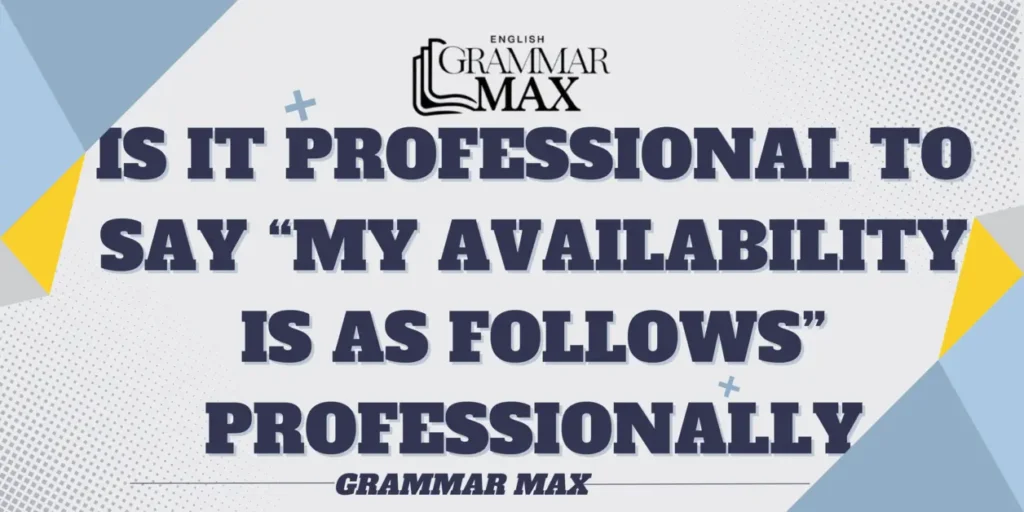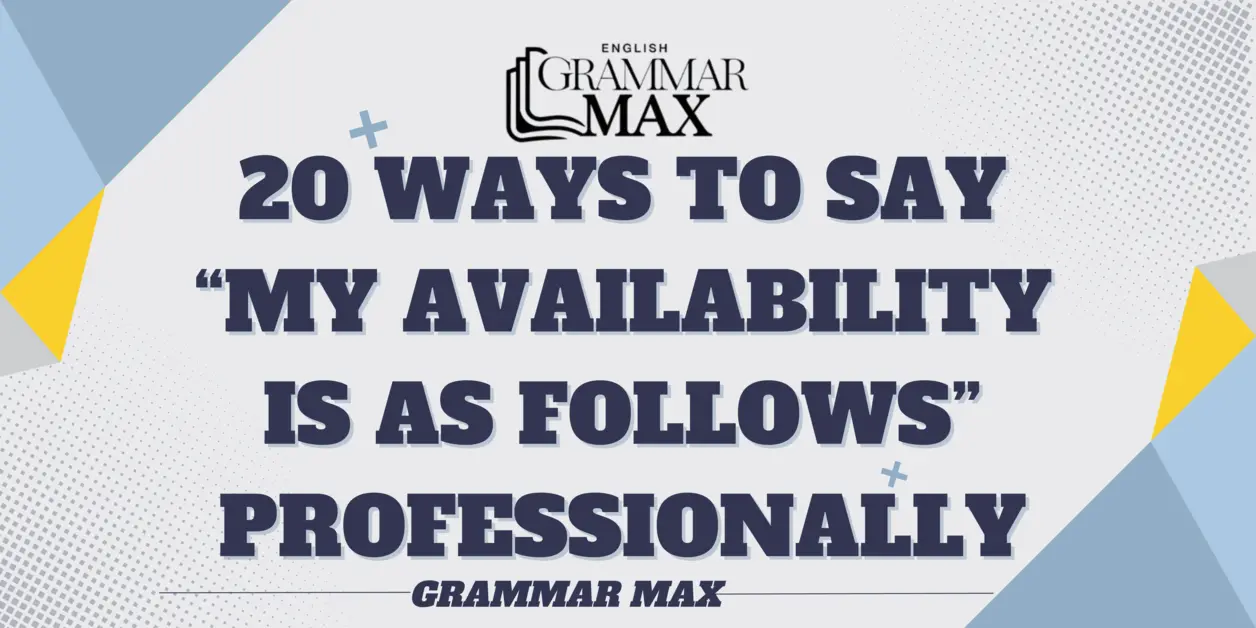My Availability Is as Follows: this phrase conveys a clear and structured message about when you can be reached or participate in scheduled activities. Using alternatives not only enhances professional communication but also improves understanding and respect in a work environment. This article will explore different ways to express availability in a formal and polished manner.
Whether you need to schedule meetings, plan a project, or collaborate efficiently, the wording matters. Let’s dive into 20 professional ways to state your availability, with examples to help you communicate in a business-appropriate tone.
Alternative ways to say “My Availability is as Follows”

You can use these ways instead to say “My Availability is as Follows”:
- I Am Available During the Following Times
- Here Are My Available Windows
- I Have Open Slots On…
- My Preferred Times Are…
- My Next Availability Is…
- I Can Make Time On…
- My Free Periods Include…
- I’m Open During These Times
- My Allocated Time for This Is…
- These Are the Time Slots I’ve Reserved
- I Can Commit to the Following Hours
- I’m Available Within This Time Frame
- I Can Schedule Meetings During…
- My Schedule Is Open On…
- I Have a Window of Opportunity On…
- I’m Free At These Times
- I’m Available for Collaboration During…
- The Best Times for Me Are…
- I’ve Allocated This Time for Our Meeting
- I Can Fit You In At…
I Am Available During the Following Times
This phrase is a clear and direct way to communicate when you are free. It’s perfect for situations where you want to provide a structured list of times.
Use it in formal emails or meeting requests to outline your availability comprehensively. It reflects professionalism and thoughtful planning.
Example Email:
“Hi Alex, I am available during the following times: Monday to Friday from 9:00 AM to 3:00 PM. Please let me know if these slots work for you.”
Here Are My Available Windows
This option suggests flexibility while giving specific time ranges. It shows that you are open to accommodating different needs within a given timeframe.
Using this phrase is helpful when you want to communicate availability for collaboration. It keeps the tone professional yet adaptable.
Best Use:
This is great for providing flexible time ranges in collaborative environments, showing that you are accommodating while still giving structure to your scheduling.
Example Email:
“Hello Sara, here are my available windows: Tuesday between 1:00 and 4:00 PM, and Thursday from 10:00 AM to 12:00 PM. Let me know which works best for you.”
I Have Open Slots On…
This phrase is ideal for listing free time slots in a way that encourages easy scheduling or booking. It’s especially useful for offering flexible options.
You can use this to propose times for meetings, showing your readiness to engage. It makes scheduling easier for everyone involved.
Example Email:
“Hi Dan, I have open slots on Wednesday from 2:00 PM to 5:00 PM. Please advise if this time suits our project discussion.”
My Preferred Times Are…
This phrase indicates when you’d most like to meet but remains open to other options. It’s perfect for suggesting your ideal hours without being too rigid.
By using this, you express a preference that allows for efficient scheduling. It communicates that you’re organized yet flexible if needed.
Best Use:
This is useful when you want to express your ideal meeting times while remaining open to alternatives, facilitating efficient scheduling.
Example Email:
“Dear Emily, my preferred times are Mondays from 10:00 AM to 1:00 PM and Fridays after 2:00 PM. Let me know if this fits into your schedule.”
My Next Availability Is…
This way of expressing availability is suitable when you’re booked in the short term but want to indicate future options. It emphasizes planning ahead.
It’s perfect for conversations where a future meeting needs to be arranged. This phrase helps in managing expectations and planning efficiently.
Example Email:
“Hi Chris, my next availability is on July 15th at 11:00 AM. If this works for you, we can plan our meeting accordingly.”
I Can Make Time On…
This option conveys a willingness to accommodate the other person’s needs. It reflects cooperation and an adaptable mindset.
Use it in contexts where you want to emphasize flexibility without giving up too much of your schedule. It’s great for collaborative projects.
Best Use:
This phrase conveys a willingness to adjust your schedule for someone else, making it perfect for collaborative projects where flexibility is key.
Example Email:
“Hey Laura, I can make time on Thursday morning or Friday afternoon. Please confirm which you’d prefer.”
My Free Periods Include…
This is a comprehensive way to outline when you are available. It works well in situations that require planning several appointments.
It allows the recipient to choose the best slot that fits both parties. This approach is helpful for structured and well-organized communication.
Example Email:
“Dear David, my free periods include Monday between 9:00 and 11:00 AM and Wednesday after 3:00 PM. Feel free to select what suits you best.”
I’m Open During These Times
This phrase is slightly casual but still maintains a professional undertone. It suggests availability in a friendly yet clear way.
It’s effective for general scheduling and leaves room for easy adjustment. Use this when you want to keep your message light but still informative.
Best Use:
This phrase is suitable for less formal communications, indicating your availability in a friendly manner while still maintaining a professional tone.
Example Email:
“Hi Kevin, I’m open during these times: Tuesday from 10:00 AM to 2:00 PM and Thursday from 1:00 PM onwards. Let me know your preference.”
My Allocated Time for This Is…
Use this phrase to show that you’ve intentionally set aside time for a specific purpose. It conveys a sense of dedication and preparation.
It’s useful for prioritizing important tasks or meetings, showing that you value the engagement. This emphasizes your commitment and reliability.
Example Email:
“Hello Rachel, my allocated time for this is Wednesday between 3:00 and 5:00 PM. Please let me know if you’re available to discuss then.”
These Are the Time Slots I’ve Reserved
This expression indicates that you have a well-planned schedule. It shows that you are proactive and have made arrangements in advance.
It’s ideal for scheduling important discussions or project-related meetings. This way, you highlight the significance of the engagement.
Best Use:
Use this phrase to indicate that you’ve proactively arranged your schedule, reinforcing your commitment to the meeting or event.
Example Email:
“Dear Jake, these are the time slots I’ve reserved for our call: Friday from 9:00 to 11:00 AM. Does this align with your availability?”
Is it Professional to Say “My Availability is as follows”?

It is generally professional to say “my availability is as follows” when outlining your schedule in a formal context. This phrase clearly communicates your open slots for meetings or appointments, helping ensure efficient scheduling. By stating “my availability” upfront, you convey your willingness to engage while maintaining a business-like tone.
However, it might come across as overly formal in some casual settings. Instead, you could use phrases like “I am available” or mention when your availability open periods are, depending on the situation and the level of formality required.
Pros
- Clear and straightforward communication
- Shows readiness and professionalism
Cons
- Might sound too rigid for casual conversations
- Can come across as impersonal or overly formal
Next Availability How to say it?
To communicate your next availability, you can say phrases like “My next open slot is on…” or “I can meet on…”. These options allow you to clearly express when you’re free while maintaining a professional tone. Using such phrases helps others get avilability efficiently and schedule appointments effectively.
Frequently Asked Questions
How do I professionally say I have availability?
You can say, “I have open slots on…” or “I am available during these times.” Both options convey your availability clearly and professionally.
How do I tell someone my availability?
You can communicate your availability by stating, “My available times are…” or “I can meet on…” to ensure clarity in scheduling.
How do I describe my availability?
Describe your availability by specifying the days and times you are free, such as “I am available on Mondays and Wednesdays from 10 AM to 2 PM.”
How do you express your availability?
You can express your availability by using phrases like “I am open to meeting during…” or “I have the following time slots available…” for clear communication.
Conclusion
Understanding how to communicate your availability is essential for fostering effective professional relationships. The 20 phrases presented offer a diverse range of options to help you get avilability across clearly and respectfully. Whether you prefer a formal or informal tone, there are various ways to express your free time effectively.
By using phrases such as “I am available” or detailing when your availability open, you can ensure that your communication is both professional and approachable. Adapting your language to suit different contexts not only enhances your work etiquette but also facilitates better scheduling and collaboration in your professional interactions.

William Henry is a writer for Grammar Max, a blog that focuses on synonyms and phrases. He loves exploring the quirks of the English language and enjoys helping readers improve their vocabulary. William’s articles are easy to read, fun, and full of useful tips for anyone looking to better understand and use English. Whether you’re a student, a professional, or just someone interested in language, William’s writing on Grammar Max makes learning about words and their meanings simple and enjoyable.
